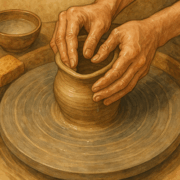A 2,000-year-old mysterious clay token
Could this ancient clay token have been used by pilgrims ascending to the Temple in Jerusalem during the Passover festival 2,000 years ago to receive sacrificial components?
Discovered more than a decade ago by the Temple Mount Sifting Project, this intriguing tiny clay token, that hasn’t yet been published, features a seal imprint of a wine jar accompanied by a Greek inscription. Its striking resemblance to another token found near the Temple Mount, which bears an Aramaic inscription, has led scholars to speculate whether these tokens were used by pilgrims for exchanging offerings during their sacred visits.

Who are you, Doulês?
In September 2011, while sorting pottery shards collected from previous siftings at the Temple Mount Sifting Project, archaeologist Gal Zagdon, who was in charge of the sifting facility, noted a tiny, irregularly shaped clay object. Upon closer inspection, it was clear that it was not a potsherd but a tiny lump of clay with a seal impression on it. Unlike common clay sealings (sometimes named bullae), its backside was pinched, suggesting it was a type of token given by hand to the recipient, unlike a sealing that was attached to a knot securing a document or container.
The seal impression depicts an amphora (a type of wine jar) known from the second half of the first century CE (approximately a century before the Second Temple’s destruction). Six Greek letters appear around the wine jar; one of them was not well preserved in the imprint, and its reading is assumed. The reading of the inscription, done with the kind help of Dr. Leah Di Segni of the Hebrew University of Jerusalem, an expert in ancient Greek epigraphy, resulted in the letters ΔΟΥ-ΛΟ[Υ] (DOULOU), the genitive of the personal name Doulês. This name was common in Thrace, Macedonia, and the northern regions of the Black Sea, areas where Jews had settled by the late Hellenistic-Early Roman periods.
The use of Seals for Offerings in the Temple
Two months after the discovery of the Greek token, another very similar token was found in excavations at the drainage channel under Robinson’s Arch (below the southern part of the Western Wall) directed by Eli Shukrun and Prof. Ronny Reich of the Israel Antiquities Authority. This token bore an Aramaic inscription reading דכא/ליה , initially interpreted as “pure to God” by the excavators. However, Hebrew University Talmudic scholar, Prof. Shlomo Naeh, later suggested that the token was used by pilgrims ascending to the Temple as a token to receive their offerings after payment, with the writing on the sealing intended to prevent forgeries by including the abbreviations of the sacrifice type, the day, the month, and the name of the priestly division of that week. This practice is attested in Tractate Shekalim (5:4) of the Mishna, the oral Jewish law compiled in the 2nd century CE. Other scholars, including Prof. Ze’ev Safrai and Dr. Avi Shweika, criticized this interpretation and suggested alternative meanings for the token.

The Aramaic token adds further context for the Greek-inscribed token from the Temple Mount. Notably, it depicts a wine jar, aligning with the Mishnaic text that discusses nesachim, a term for the wine libation poured on the Temple altar and also used to refer generally to all the offering components. It is plausible that this token was intended for Greek-speaking pilgrims, possibly including Jews from the diaspora. Significantly, the Mishna confirms the presence of Greek writing in the Temple, noting in another chapter of Tractate Shekalim (3:2) that baskets in the treasury chamber were marked with Greek letters.

Clay Tokens at the Proximity of the Temple Mount

In research conducted for the Roger and Susan Hertog Center at the Hebrew University Institute of Archaeology, Dr. Yoav Farhi published a comprehensive paper on several clay tokens found in Jerusalem. Among them the two mentioned above, another token from the Temple Mount Sifting Project with a poorly preserved impression and another found in 1970 during the Jewish Quarter excavations by Prof. Nachman Avigad. The latter bore a seal impression depicting a chalice symbol also appearing on shekel coins from the last days of the Second Temple period, typically interpreted as one of the Temple vessels. Dr. Farhi confirmed Dr. Leah Di Segni’s reading of the Greek inscribed token from the Temple Mount and examined the composition of the clay of the tokens, with the help of Prof. Yuval Goren from Ben-Gurion University, finding similarities between the token from the Jewish Quarter and that from the Temple Mount.
It is worth mentioning that clay sealings from the Early Roman period (the last two centuries of the Second Temple period) are very rare finds in Israel, and clay tokens with a pinched reverse side are not known from any other sites. All four tokens studied by Dr. Farhi were found in the proximity of the Temple Mount, and were likely associated in some way with the activities that took place in the Temple. Their style is completely different from that of other known tokens from the Roman world.
Many questions remain unanswered regarding these tokens: Who used them? Who issued them? How were they used? What is the significance of the wine jar symbol on the Greek inscribed token? Who was Doulês? Is the last letter in this name, which was poorly preserved, really an Upsilon? Are there other possible readings of this inscription?

Discover more from The Temple Mount Sifting Project
Subscribe to get the latest posts sent to your email.












Leave a Reply
Want to join the discussion?Feel free to contribute!